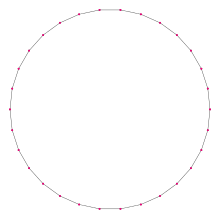Triacontagon
| Regular triacontagon | |
|---|---|

A regular triacontagon
|
|
| Type | Regular polygon |
| Edges and vertices | 30 |
| Schläfli symbol | {30}, t{15} |
| Coxeter diagram |
|
| Symmetry group | Dihedral (D30), order 2×30 |
| Internal angle (degrees) | 168° |
| Dual polygon | Self |
| Properties | Convex, cyclic, equilateral, isogonal, isotoxal |
In geometry, a triacontagon or 30-gon is a thirty-sided polygon. The sum of any triacontagon's interior angles is 5040 degrees.
The regular triacontagon is a constructible polygon, by an edge-bisection of a regular pentadecagon, and can also be constructed as a truncated pentadecagon, t{15}. A truncated triacontagon, t{30}, is a hexacontagon, {60}.
One interior angle in a regular triacontagon is 168°, meaning that one exterior angle would be 12°. The triacontagon is the largest regular polygon whose interior angle is the sum of the interior angles of smaller polygons: 168° is the sum of the interior angles of the equilateral triangle (60°) and the regular pentagon (108°).
The area of a regular triacontagon is (with t = edge length)
The inradius of a regular triacontagon is
The circumradius of a regular triacontagon is
As 30 = 2 × 3 × 5, a regular triacontagon is constructible using a compass and straightedge.
The regular triacontagon has Dih30dihedral symmetry, order 60, represented by 30 lines of reflection. Dih30 has 7 dihedral subgroups: Dih15, (Dih10, Dih5), (Dih6, Dih3), and (Dih2, Dih1). It also has eight more cyclic symmetries as subgroups: (Z30, Z15), (Z10, Z5), (Z6, Z3), and (Z2, Z1), with Zn representing π/n radian rotational symmetry.
...
Wikipedia
